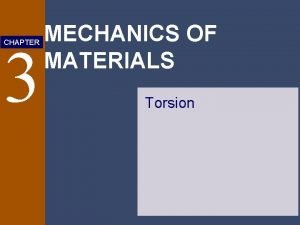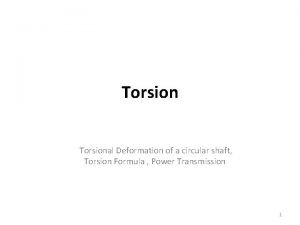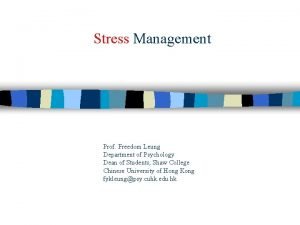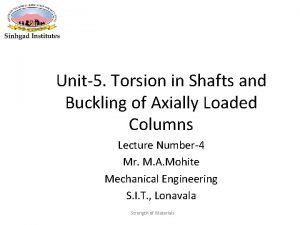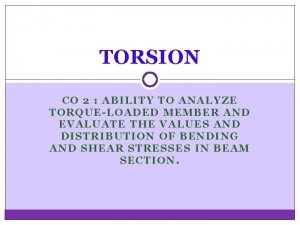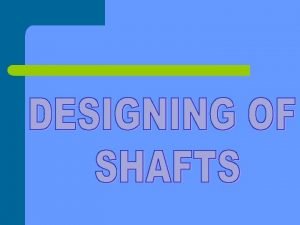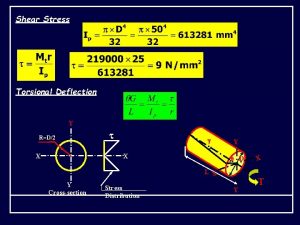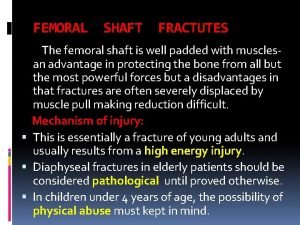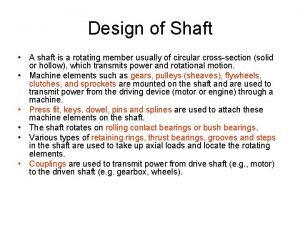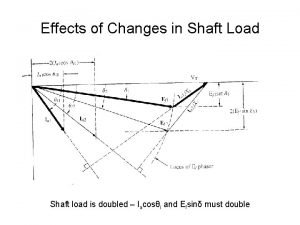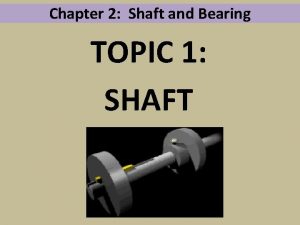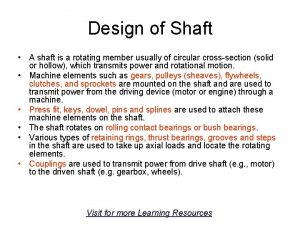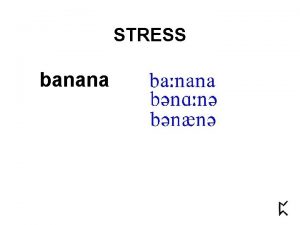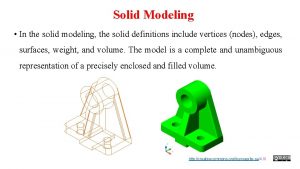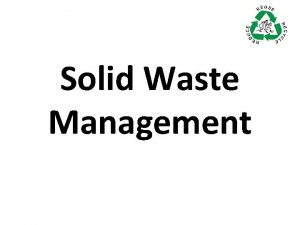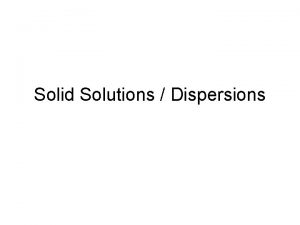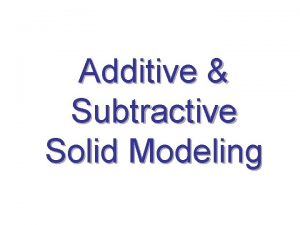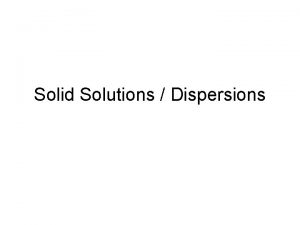SUMMARY SHAFT UNDER SHEARY STRESS Solid shaft RD2





















- Slides: 21

SUMMARY (SHAFT UNDER SHEARY STRESS) Solid shaft R=D/2 X X Y Hollow shaft Cross-section Stress Distribution Y R=Do /2 X X Y Cross-section Stress Distribution 1

5. 2 SHAFTS UNDER BENDING MOMENT The shafts; which rotate under the action of pure bending moment; are subjected to a uni-axial state of tensile and compressive stress. This also the case of the axles, which transmit bending moment only The design of both of them should be based on the following bending equation: Gear 1 A Gear 3 B Gear 2 C Design- Gearbox- Animation 2

Gear 1 Gear 3 Gear 2 Mt 1 A B Mt 2 C Mt 1 < Mt 2 N 1 > N 2 3

Y R=D/2 X A X Y where; Stress Distribution Cross-section M : Maximum bending moment acting on the critical section in N. mm I : Second moment of inertia of the cross section about the axis of rotation in mm 4. b : Normal stress due to bending moment in kp/cm y : The distance from the neutral axis to the outer most fiber on which the stress is maximal in mm. 4

For solid circular shaft: & Therefore, the diameter of solid shafts can be determined from the following equation: 5

For hollow circular shaft: & or, Therefore, the diameter of solid shafts can be determined from the following equation: 6

5. 3 SHAFTS SUBJECTED TO COMBINED STATE OF STRESS In most practical cases, the shafts are subjected in general into a combination of bending and twisting moments as well as normal force. The design of these shafts should be based on the simultaneously effect of all the loading elements. The theories of elastic failure must be carefully utilized. According to practical experience, the following two theories are important in the design of these shafts: 1 - Maximum shear stress theory of elastic failure (Guest`s theory) 2 - Maximum normal stress theory (Rankine`s theory). 7

Maximum Shear Theory According to the maximum shear stress theory of elastic failure, the maximum shear stress in the shaft can be expressed as follows: Where, s : Shear stress due to twisting moment. b : Normal stress due to bending moment. 8

Replacing the normal and shear stresses with their equations, which are functions of the shaft diameter and the loads (i. e. bending and twisting moments), the following relation can be obtained: Te is known as the equivalent twisting moment. 9

Therefore, the following equation can be used to evaluate the diameter of the shaft according to the maximum shear stress theory of elastic failure. 10

In The case of hollow shafts, the external diameter can be determined according to the following equation: 11

Maximum normal stress theory According to the maximum normal stress theory of elastic failure, the maximum normal stress in the shaft can be expressed as follows: Where, yt : Yield stress of shaft material, N/mm 2 1 : Maximum principale stress, N/mm 2 Where, s : Shear stress due to twisting moment, N/mm 2. b : Normal stress due to bending moment, N/mm 2. 12

Using the same treatment that has been used in the maximum shear stress theory, the following equation can be obtained: The term is defined as the equivalent bending moment, i. e. : 13

In The case of hollow shafts, the external diameter can be determined according to the following equation: 14

The following table summarize the equations used in design of shaft using the allowable stress as material property. Method Solid Shaft Hollow Shaft Pure Shear Stress (Mt) Pure Normal Stress (Mb) Max. Shear Theory (Mb &Mt) Principle Normal Stress Theory (Mb &Mt) 15

SOLVED PROPLEM (1) A line shaft rotates at 200 r. p. m. and transmits 25 HP. The shaft made of mild steel with an allowable shear stress of 420 kp/cm 2. Determine the diameter of the shaft neglecting the bending moment on it. SOLUTION Given N = 200 r. p. m. P = 25 h. p. ( all ) = 420 kp/cm 2 16

I. Determination of thetransmitted torque: Let i. e. T = Torque transmitted by the shaft T=8950 kp. cm 17

I. II. Diameter of the shaft Let d = shaft diameter i. e. Therefore, d =47. 7 mm d = 50 mm 18

SOLVED PROPLEM (2) Find the diameter of a solid steel shaft transmits 25 HP at 200 r. p. m. The ultimate shear stress is 3600 kp/cm 2 and a factor of safety as 8. If a hollow shaft is assumed to replace it, find the inside and outside diameters when a ratio of inside diameter to outside diameter of 0. 5 is assumed. SOLUTION Given Horse power transmitted, P =25 h. p. Speed of shaft, N =200 r. p. m. Ultimate shear stress, u =3600 kp/cm 2 Factor of safety n =8 Allowable shear stress, all = 3600/8 =450 kp/cm 2 19

I. Determination of thetransmitted torque: Let i. e. T = Torque transmitted by the shaft T=8950 kp. cm 20

II. Diameter of the shaft Let d = shaft diameter i. e. Therefore, d =47. 7 mm d = 50 mm 21
 Torsion
Torsion Torsion
Torsion True fracture strain
True fracture strain Axial stress vs normal stress
Axial stress vs normal stress Chapter 10 stress responses and stress management
Chapter 10 stress responses and stress management Style under stress assessment
Style under stress assessment Dearman technique
Dearman technique Chem
Chem Example solid solution
Example solid solution Covalent network solid vs molecular solid
Covalent network solid vs molecular solid Lattice basis
Lattice basis Crystal solid and amorphous solid
Crystal solid and amorphous solid Crystalline solid and amorphous solid
Crystalline solid and amorphous solid Anisotropic meaning in chemistry
Anisotropic meaning in chemistry When a solid completely penetrates another solid
When a solid completely penetrates another solid When a solid completely penetrates another solid
When a solid completely penetrates another solid Evaporation separation examples
Evaporation separation examples Freedom leung
Freedom leung Under the mesquite summary
Under the mesquite summary Slenderness ratio formula
Slenderness ratio formula Internal torque equation
Internal torque equation A shaft is designed on the basis of
A shaft is designed on the basis of
